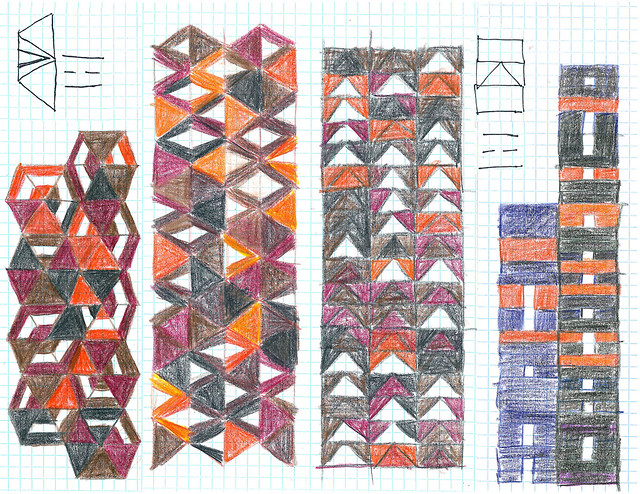I Ching Modern Quilt-along: Week 7 ~ Translating

Introduction
Over the last several weeks we have begun READING and documenting our I Ching castings into our daily creative process. The next step in the I Ching Modern Quilt-along is TRANSLATING these random readings into a quilt form.
So here is the thing. If you read my blog you know that most of my quilts are improvised. I've written extensively about the modern improv quilt making process.
The I Ching Modern Quilt is NOT improvised. It is completely determined by a random process. Once you decide on a form for translating your I Ching hexagrams, there are no more decisions to be made. Improvising however requires a choice every moment of the process.
How are these two processes linked - random vs. improv? And what is the value of making a quilt using a random process if you are into improvising?
Many people who view an improvised quilt will comment on how random it looks. A random factor infused into the improv process will loosen up the imagination and break us out of a rut.
What does randomness look like? What does fate feel like?
If you improvise on a regular basis, notice how it feels not making any decisions and merely executing fate. If you follow traditional patterns and map out your quilts in an orderly way before hand, notice how it feels to make predetermined but unpredictable blocks. In other words notice your rhythm of attention!
Information

Now is the time to get out your graph paper and use the I Ching castings that you have already documented to decide on the form that your quilt will take.
Assign Color Sets
Your hexagrams have three variables - unchanging lines, changing lines, and the spaces between broken lines. See the step on CASTINGfor a refresher on how to document the unchanging and changing lines of your hexagrams.
Previously you gathered three sets of colors. Now assign each set to one of the variables listed above. I will use my dark set of neutrals for the unchanging lines, my set of bright colors for my changing lines, and my light set of neutrals for the spaces between the broken lines.

You can invert this relationship if you want more of a white quilt (see right). Or you can use your bright colors for the spaces and your light set of neutrals for the changing lines, etc.
Check out this link for more clarification on how to choose fabrics for dynamic color sets.
Choosing/Creating The Form (Block Pattern)
In this post I've include several sketches of different translations using the same set of castings. Notice how the randomness plays out differently in each form!
Remember we are working with six lines or a hexagram, made up of three lines or trigram. The sketches above include two different hexagon patterns, a traditional flying geese pattern and a simple strip pattern in two different dimensions.
When sketching out your translations build the pattern from the bottom right corner just as the I Ching hexagram grows from bottom to top. Since the primary hexagram contains the relational hexagram if there is one, I've only included primary hexagrams in my translations.
i_ching_50_ting
Usually when you see a hexagram drawn out you see spaces between each line. Notice that in my translations I am not including the horizontal spaces between the lines themselves. I'm only including spaces between broken lines. I think this abstraction creates the modern feel, but of course you are welcome to include these horizontal spaces in your translation.
I may make more than one I Ching Modern Quilt, but for my first one I will be using the simple strip pattern in the dimensions of a 12" x 18" block (see sketch at top of Information section).
Think of the ways you can adapt traditional patterns such as Log Cabin and others, to translate your random castings. The possibilities are plentiful.
Calculating Sizes and Quantity
Use the graph paper to help you calculate the size of your blocks, the size of the individual pieces that compose the blocks, and how many blocks you will need to make the size quilt you want to have.
Assignment
Get your graph paper out and your colored pencils and have some fun designing the way you want to translate your castings. Sketch out several options including ones based on traditional block patterns, and ones that you design yourself. Don't map out the entire quilt using every casting, you only need a sample. Be sure that whatever you design you can figure out how to sew it!
If you want to use the same translation I'm using, I will provide complete sewing instructions, starting with measurements in the next installment of the quilt-along when we begin CUTTING.
If you have clarifying questions please post them in the comments and I will respond. I've also set up an I Ching Modern Flickr Group if you want to post images of your sketches, process, and final results.
It's never too late to join an online quilt-along! I'll be posting new segments of the quilt-along on Mondays. Access the archive and subscribe to the RSS feed here: I Ching Modern Quilt-along.

